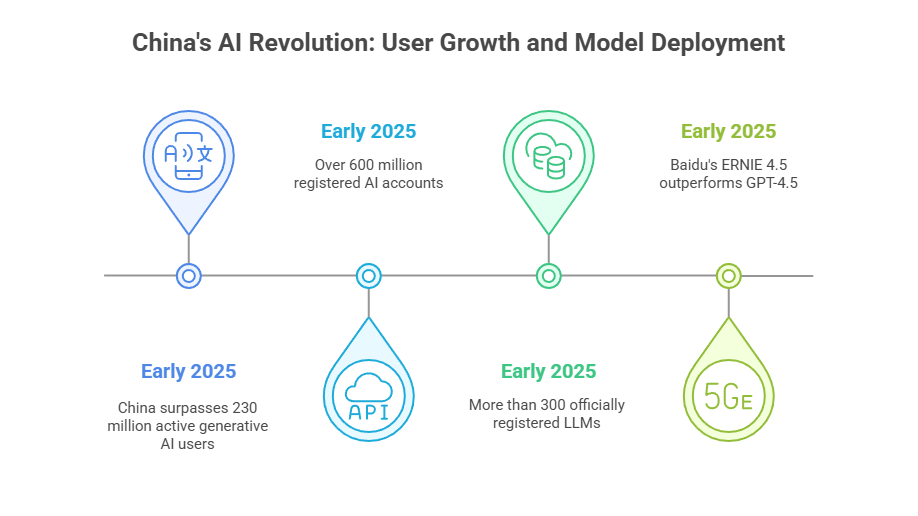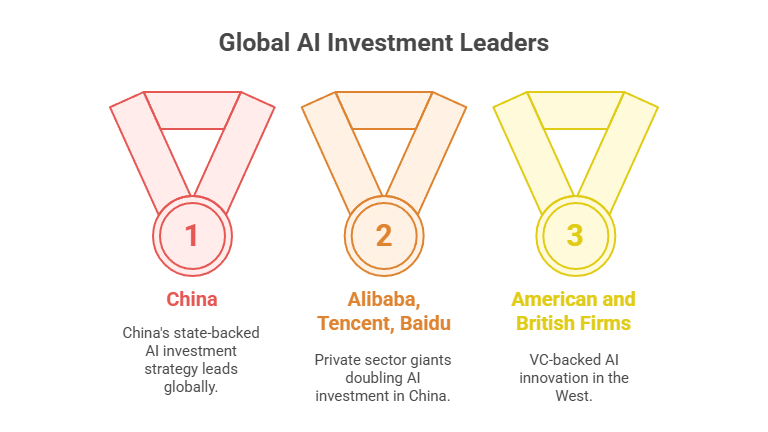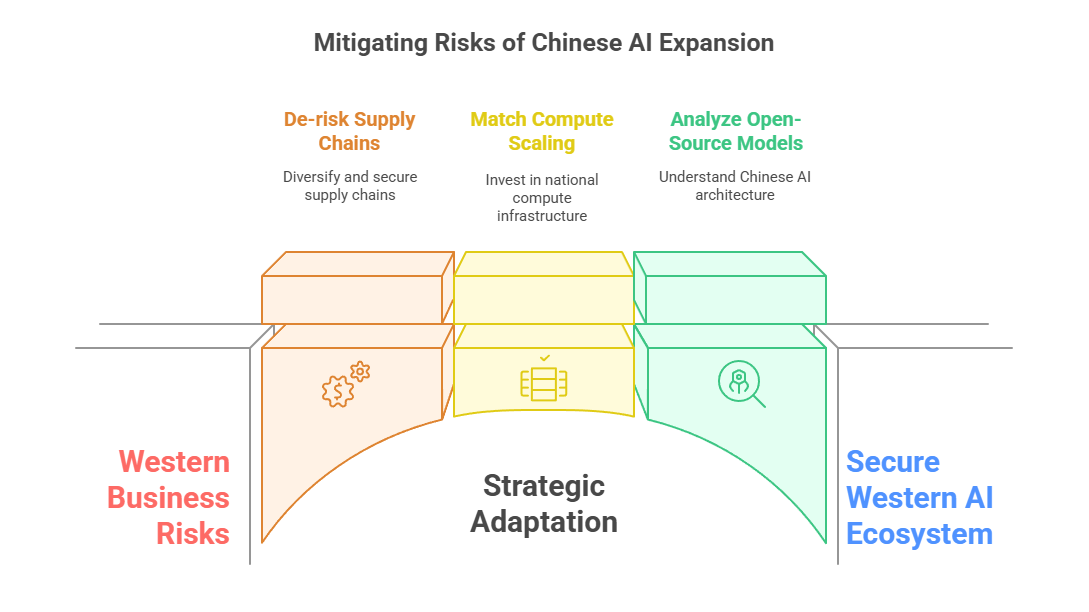
A New Era of Chinese AI Dominance
The rapid evolution of new Chinese AI technologies in 2025 is not just reshaping local industries—it’s redrawing the entire map of global competition. With over 300 large AI models officially registered and more than 600 million Chinese users adopting generative AI, China is positioning itself as a global AI powerhouse. What was once seen as a follower in the AI race is now a leader challenging American and British tech dominance.
For businesses in the US and UK, understanding China’s AI expansion is more than academic—it’s strategic. This blog explores how China’s AI infrastructure, model innovation, enterprise adoption, and state funding are influencing global markets and what Western firms can learn or counteract.
Explosive User Growth and AI Model Deployment

By early 2025, China surpassed 230 million active generative AI users, with over 600 million registered accounts—a staggering adoption rate representing about one in six internet users in China. This growth has paralleled an explosion of large language models (LLMs), with more than 300 officially registered models, and hundreds more being tested in industry-specific domains.
The sheer scale of this ecosystem is matched by its diversity. From Alibaba’s Qwen models to Baidu’s ERNIE X1 Turbo, Chinese firms are no longer replicating Western models—they’re building competitive, often superior alternatives optimized for local and global applications. Notably, Baidu’s ERNIE 4.5 has even outperformed GPT-4.5 in several benchmarks.
Model Innovation: From Reasoning to Multimodal Intelligence

Chinese AI innovation is shifting from quantity to quality and specialization. While the West focuses on general-purpose AI, Chinese companies are building domain-specific and reasoning-first models. For instance, Moonshot AI’s Kimi 1.5, launched in January 2025, rivals OpenAI’s o1 in math, code, and multimodal benchmarks.
Huawei’s PanGu-Σ, a trillion-parameter model, and its latest PanGu-5.0 are also breaking new ground in scientific and industrial applications. Similarly, Alibaba’s Qwen-Omni-7B and QwQ-32B emphasize logic reasoning, hinting at a future of Chinese models that can power critical business, legal, and medical decisions.
These models aren’t isolated lab projects. They’re being deployed at scale in hospitals, logistics centers, and self-driving platforms—forming the backbone of a pragmatic AI infrastructure, in stark contrast to some Western models that remain research-focused.
Strategic Government and Private Sector Funding

The Chinese government is not shy about its ambitions. Through the Bank of China, it plans to channel ¥300 billion (~$42 billion) into AI projects via stock and debt instruments over five years. This is part of a broader ¥1 trillion national AI investment strategy, making it one of the most ambitious globally.
Private players are equally aggressive. In mid-2024, Alibaba, Tencent, and Baidu doubled their capex to ¥50 billion (~$7 billion), focusing on data centers, chip design, and AI-as-a-Service platforms.
While American and British firms rely heavily on VC funding and organic innovation, China is deploying state-backed capitalism—giving its AI companies infrastructure, protection, and patient capital to dominate long-term.
Enterprise Integration: China’s AI in the Real World

Perhaps the most striking difference is how deeply Chinese AI is integrated into business operations. In a 2024 SAS report, 83% of Chinese enterprises were using generative AI, compared to 54% globally.
From healthcare AI like DeepSeek rolled out across tertiary hospitals, to autonomous driving with companies like XPeng and Baidu Apollo leading Level-4 robotaxi pilot programs, the new Chinese AI ecosystem is already transforming entire sectors.
US and UK businesses—especially in logistics, real estate, retail, and telemedicine—need to watch these developments closely. It’s not just about competition—it’s about anticipating how Chinese AI standards might influence global regulations, technical expectations, and even labor markets.
What This Means for Western Businesses and Policy

For US and UK firms, the rise of new Chinese AI represents both a wake-up call and a learning opportunity. Key strategic questions include:
-
How can Western companies de-risk their supply chains if Chinese AI becomes embedded in core logistics or chips?
-
Will Chinese LLMs undercut American AI SaaS platforms on cost or performance in global markets?
-
Should UK or US regulators consider national compute infrastructure investments to match China’s EFLOPS scaling?
It’s also worth noting that Chinese companies are open-sourcing models aggressively, like Alibaba’s Qwen series, now downloaded over 40 million times. This openness could democratize AI globally—but also embed Chinese AI architecture into foreign ecosystems.
For small to mid-sized businesses in the US and UK, the AI race between the West and China might feel distant—but its impact is very real. Whether it’s optimizing workflows, analyzing competitive benchmarks, or automating tasks using multilingual AI tools, staying competitive means staying ahead of the curve.
TaskVirtual, a leading AI Virtual Assistant service provider, offers:
-
Expert consultation on integrating AI-powered tools for content rewriting, SEO, customer support, and market analysis.
-
Affordable pricing between $3.12/hour to $14.99/hour, making enterprise-grade support accessible to startups and SMEs.
-
A proven record with 364 positive reviews and a 4.7-star rating across trusted VA platforms.
Whether you’re seeking a virtual assistant who can monitor Chinese AI trends or one who can help integrate open-source LLMs like Qwen into your systems, TaskVirtual brings AI literacy to your workflow—cost-effectively.
Conclusion: Eyes on the East, Strategy in the West
The new Chinese AI wave is more than a trend—it’s a transformative force altering the global digital economy. With state-driven infrastructure, next-gen models, and massive enterprise deployment, China is now an AI superpower shaping tomorrow’s technological standards.
For businesses in the US and UK, the challenge is not just keeping pace—it’s learning when to collaborate, when to compete, and when to adapt. And with smart partners like TaskVirtual helping you leverage AI for daily operations, you can remain focused on growth—while keeping an eye on the East.






